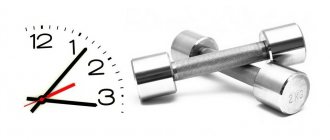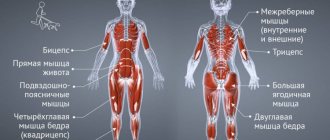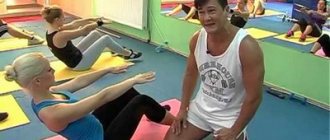Scientific research
During training, a person produces two types of hormones - anabolic and catabolic. The first group includes testosterone, somatotropin (growth hormone) and insulin. They help restore muscles that are damaged during physical activity, and also participate in the construction of new muscle tissue.
Somatotropin, in addition to the muscle restoration function, strengthens bone and connective tissue, reduces body fat, and causes muscle growth.
The catabolic hormones cortisol and glacogon increase blood glucose and stimulate metabolism, but in large quantities they provoke an increase in blood pressure, worsen the protective properties of the immune system, destroy muscle tissue and prevent the construction of new ones.
Cortisol and glacagon destroy muscle tissue and prevent the construction of new ones.
After conducting a number of studies, it was found that the first 20 minutes of training consume glycogen from the muscles, and the next 20 - from the liver. That is why the optimal duration of exercise in the gym is 40-45 minutes. After 45 minutes of training, cortisol levels increase and catabolic processes begin, which have a detrimental effect on muscles.
The permissible peak of cortisol is observed at the 60th minute of training, so training beyond this time is not only impractical, but also dangerous. What could this mean:
- Decreased production of testosterone and somatotropin;
- Increased risk of injury;
- Overtraining.
To properly build a training program, it is enough to take into account two points: testosterone, which is responsible for the progress of athletes, is produced in the first 30-45 minutes of training, and the production of cortisol, which destroys muscles, begins after 45 minutes.
Is it possible to exercise every day?
In no case should you resort to strength training every day; a number of arguments can be given in favor of this argument:
- The quality of each subsequent lesson deteriorates significantly
, as excessive fatigue accumulates in the body. - A decrease in testosterone production and a simultaneous increase in cortisol levels does not contribute to the gain of muscle mass, but to the destruction of building fibers
, which worsens physical fitness.
- Glycogen reserves are depleted
, which is a necessary source of energy in the body, in particular during sports exercises. - The cardiovascular and musculoskeletal systems are subjected to too much stress, which has a detrimental effect on them.
- Mental health suffers
as chronic fatigue reduces energy, self-confidence and motivation.
In addition, high frequency of training involves the use of so-called anti-catabolics
- substances that prevent the destruction of muscle tissue and are used in preparing professional athletes for competitions.
Important!
Exercising too infrequently will also
not bring any benefits to the body
, because they are not able to affect the growth of muscle mass.
Practical advice
Some people who have just started working out in the gym make a number of mistakes:
- Exercising too much (more than 1 hour);
- They do little (less than half an hour);
- They use a large number of simulators and equipment (more than 5-7 units).
Long-term training negatively affects the state of the hormonal system responsible for the athlete’s progress.
If short workouts and chaotic use of more than seven exercise machines in one visit are unlikely to bring visible results, then overdoing it in terms of duration of classes can cause great harm:
- The condition of the muscular system deteriorates. During training, the body experiences stress, and muscles are damaged, because without this their growth is impossible. That is why they need recovery, on which the success of their studies also largely depends. If you exercise too often and for a long time, the muscular system will not have time to recover;
- Lack of oxygen. Energy production during weightlifting exercises lasting less than two minutes is performed without oxygen. Low-intensity long-term training, on the contrary, actively uses it to burn fat and glycogen reserves;
- Overtraining. This is the main enemy of athletes: until the muscles are at least partially restored, there is no point in going to the next workout. This condition is usually accompanied by catabolic processes to a greater extent than with moderate physical activity.
The duration of the workout depends mainly on the program: for example, aerobic training for fat burning should last from 40 to 60 minutes, while training with barbells and strength training equipment should be limited to 45 minutes. Pre-warm-up is not included in the total duration of the lesson.
The most popular are two training systems:
- Split: individual muscle groups are worked out in one session;
- Fullbody (circuit training): involves working on all muscles.
In the first case, most often a large number of repetitions and a minimum of approaches are performed, between which there is a long rest (up to 1 minute), and in the second the opposite is true: the frequency of repetitions decreases, but the approaches increase, and the rest between them is reduced to 10-20 seconds. This also needs to be taken into account when building a training program.
What beginners need to know:
- Using a large number of simulators does not guarantee good results. Normally, three basic and two isolating exercises are enough for a workout;
- Long-term training negatively affects the state of the hormonal system responsible for the athlete’s progress: they activate catabolism and prevent anabolism;
- Short sessions (less than half an hour) do not have a significant impact on the result, because the body does not produce enough hormones and other substances to quickly build muscle tissue and burn fat, and the muscles themselves do not receive optimal load.
Best time for training
- In the evening, the production of testosterone, necessary for muscle growth, increases, which contributes to achieving better results when gaining weight.
- Cortisol levels in the afternoon are significantly lower than in the morning, which has a positive effect on increasing muscle strength and volume.
- In the evening, body temperature rises slightly, which contributes to better recovery of muscle fibers
after intense power loads. - In the second half, the body is already somewhat warmed up and prepared for strength training.
Reference.
Despite the undeniable benefits of evening strength training,
for “early people”
to achieve better results when performing a workout in the first half of the day.
The timing of the classes is selected in accordance with the individual daily routine of each person. Before strength training, the body should be given the opportunity to rest for 1 hour.
Therefore, when working in the evening, preference is given to classes in the first half of the day.
How do pharmacology and stimulants affect the duration of training?
After taking pharmacological drugs, many athletes, even after two hours in the gym, practically do not feel tired.
In bodybuilding, pharmacological drugs (steroidal and non-steroidal), as well as isotonics and pre-workout complexes, are widely used. They have different principles of action, but they all have one thing in common - the ability to increase endurance and strength. For this reason, many athletes, even after two hours in the gym, practically do not feel tired, but it is not recommended to exercise for more than 60 minutes:
- Hormones continue to be produced according to the same principle as without drugs (anabolic steroids are an exception, since they enhance the production of male sex hormones);
- Pharmacological non-steroidal drugs for fat burning often weaken the body, especially during drying, and prolonged physical activity can lead to fainting (for example, Metformin, Clenbuterol, etc.).
While taking steroids, training should be as intense as possible, but do not forget about breaks and recovery, which play a key role. Beginners are not recommended to use such drugs.
After training - go to the sauna!
Spend 60% of your training time on cardio. If you want to lose weight, do cardio exercises after strength training. During resistance exercise, carbohydrates are primarily used. Therefore, when you switch to cardio, fat reserves will be burned.
Monitor the load during continuous movement. To get rid of extra pounds, you need to give your best, but monitor your heart rate - it should be within the fat burning zone (50-65% of the upper value). The calculations are simple: you need to subtract your age from 220 - this is the limit.
For weight loss, interval training is recommended: exercise at an intense pace for a minute, and then 1-2 minutes at a more relaxed pace. You can increase the time of intense training and reduce training at a recovery pace.
If you don't have time to go to the gym, do a quick workout. Pick up a few multi-joint exercises and run them around in circles several times at high intensity.
Fitness instructors recommend visiting the sauna after training. Warming up the body increases blood flow, it is saturated with oxygen and the fat burning process is activated.
After the sauna, metabolic products are eliminated, muscle pain subsides, and excess fluid “evaporates” from the body. As a result, cellulite becomes less noticeable and body volume decreases.
We invite you to familiarize yourself with Bent-over barbell rows for girls
You can go to the sauna 2-3 times a day, the temperature should be up to 60 degrees. It is useful to drink herbal teas or mineral water.
How to properly organize your training process?
It all depends on the ultimate goal - losing weight or gaining weight - but in both cases the following tips for organizing training will be relevant:
- Do not visit the hall during rush hour. At this time, queues line up at the exercise machines, which increases the rest time between approaches;
- To burn fat, you need to combine strength and aerobic training, and to gain muscle mass, on the contrary, do it on different days;
- Do not be distracted from the exercises: this negatively affects the execution technique and increases time costs;
- Change your training program periodically. A signal to change the program is a deterioration or suspension of progress;
- Use supersets. They increase the intensity level of the activity;
- Take 1.5 liters of still water with you. This will reduce the time spent on trips to the cooler between approaches.
How many times a week should you exercise?
Photo pexels.com
On the website for Adidas' official fitness app, Runtastic, personal trainer Sven Fredrich wrote that the optimal number of sessions per week varies from person to person and depends on many factors related to goals, fitness and fitness level.
Fellow personal trainer Tom Mans, in an interview with The Independent, stressed that when creating a training schedule, you also need to take into account the type of sport or combination of several types of exercises you do.
But although when determining the load it is worth starting primarily from the individual characteristics of each individual person, Mance nevertheless derived a certain universal formula. According to him, training once or twice a week can only provide a low level of physical fitness.
And if you want to stay fit and healthy, then you should train three times a week
. However, there are some nuances here.











